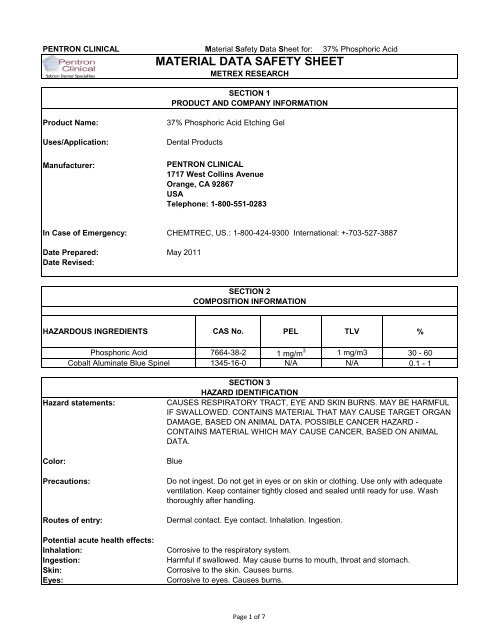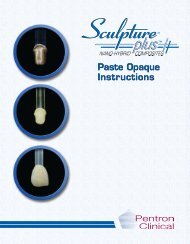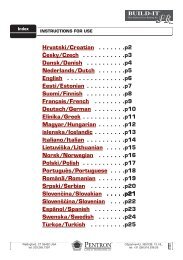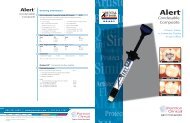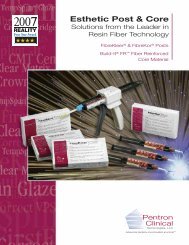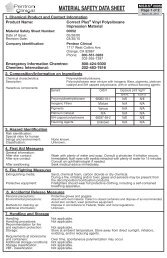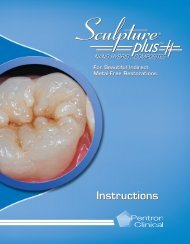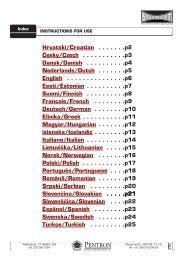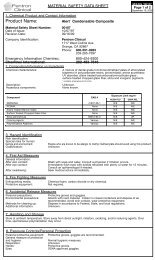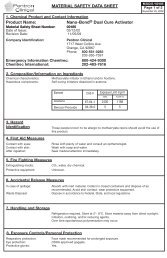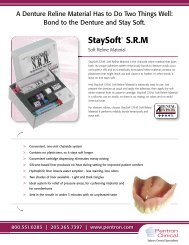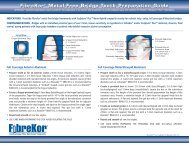37% Phosphoric Acid Etch Gel MSDS - Pentron Clinical
37% Phosphoric Acid Etch Gel MSDS - Pentron Clinical
37% Phosphoric Acid Etch Gel MSDS - Pentron Clinical
Create successful ePaper yourself
Turn your PDF publications into a flip-book with our unique Google optimized e-Paper software.
PENTRON CLINICAL Material Safety Data Sheet for: <strong>37%</strong> <strong>Phosphoric</strong> <strong>Acid</strong><br />
MATERIAL DATA SAFETY SHEET<br />
METREX RESEARCH<br />
SECTION 1<br />
PRODUCT AND COMPANY INFORMATION<br />
Product Name:<br />
Uses/Application:<br />
Manufacturer:<br />
<strong>37%</strong> <strong>Phosphoric</strong> <strong>Acid</strong> <strong>Etch</strong>ing <strong>Gel</strong><br />
Dental Products<br />
PENTRON CLINICAL<br />
1717 West Collins Avenue<br />
Orange, CA 92867<br />
USA<br />
Telephone: 1-800-551-0283<br />
In Case of Emergency: CHEMTREC, US.: 1-800-424-9300 International: +-703-527-3887<br />
Date Prepared:<br />
Date Revised:<br />
May 2011<br />
SECTION 2<br />
COMPOSITION INFORMATION<br />
HAZARDOUS INGREDIENTS CAS No. PEL TLV<br />
%<br />
<strong>Phosphoric</strong> <strong>Acid</strong><br />
Cobalt Aluminate Blue Spinel<br />
7664-38-2<br />
1345-16-0<br />
1 mg/m 3<br />
N/A<br />
1 mg/m3<br />
N/A<br />
30 - 60<br />
0.1 - 1<br />
Hazard statements:<br />
Color:<br />
Precautions:<br />
Routes of entry:<br />
Potential acute health effects:<br />
Inhalation:<br />
Ingestion:<br />
Skin:<br />
Eyes:<br />
SECTION 3<br />
HAZARD IDENTIFICATION<br />
CAUSES RESPIRATORY TRACT, EYE AND SKIN BURNS. MAY BE HARMFUL<br />
IF SWALLOWED. CONTAINS MATERIAL THAT MAY CAUSE TARGET ORGAN<br />
DAMAGE, BASED ON ANIMAL DATA. POSSIBLE CANCER HAZARD -<br />
CONTAINS MATERIAL WHICH MAY CAUSE CANCER, BASED ON ANIMAL<br />
DATA.<br />
Blue<br />
Do not ingest. Do not get in eyes or on skin or clothing. Use only with adequate<br />
ventilation. Keep container tightly closed and sealed until ready for use. Wash<br />
thoroughly after handling.<br />
Dermal contact. Eye contact. Inhalation. Ingestion.<br />
Corrosive to the respiratory system.<br />
Harmful if swallowed. May cause burns to mouth, throat and stomach.<br />
Corrosive to the skin. Causes burns.<br />
Corrosive to eyes. Causes burns.<br />
Page 1 of 7
PENTRON CLINICAL Material Safety Data Sheet for: <strong>37%</strong> <strong>Phosphoric</strong> <strong>Acid</strong><br />
Potential chronic health effects:<br />
Chronic effects:<br />
Contains material that may cause target organ damage, based on animal data.<br />
Target organs:<br />
Carcinogenicity classification:<br />
Mutagenicity:<br />
Teratogenicity:<br />
Developmental effects:<br />
Fertility effects:<br />
Skin:<br />
Eyes:<br />
Inhalation:<br />
Ingestion:<br />
Note to physician:<br />
Flammability of the product:<br />
Contains material which may cause damage to the following organs: upper<br />
respiratory tract, skin, eye, lens or cornea.<br />
Contains material which may cause cancer, based on animal data. Risk of cancer<br />
depends on duration and level of exposure.<br />
No known significant effects or critical hazards.<br />
No known significant effects or critical hazards.<br />
No known significant effects or critical hazards.<br />
No known significant effects or critical hazards.<br />
SECTION 4<br />
EMERGENCY FIRST AID PROCEDURES<br />
In case of contact, immediately flush skin with plenty of water for at least 15<br />
minutes while removing contaminated clothing and shoes. Wash clothing before<br />
reuse. Get medical attention if symptoms persist.<br />
Check for and remove any contact lenses. Immediately flush eyes with plenty of<br />
water for at least 15 minutes, occasionally lifting the upper and lower eyelids. Get<br />
medical attention immediately.<br />
Move exposed person to fresh air. If not breathing, if breathing is irregular or if<br />
respiratory arrest occurs, provide artificial respiration or oxygen by trained<br />
personnel. Get medical attention immediately.<br />
Wash out mouth with water. Do not induce vomiting unless directed to do so by<br />
medical personnel. Never give anything by mouth to an unconscious person. Get<br />
medical attention if symptoms persist.<br />
In case of inhalation of decomposition products in a fire, symptoms may be<br />
delayed. The exposed person may need to be kept under medical surveillance for<br />
48 hours.<br />
SECTION 5<br />
FIRE AND EXPLOSION HAZARD DATA<br />
In a fire or if heated, a pressure increase will occur and the container may burst.<br />
Extinguishing media:<br />
Suitable:<br />
Not suitable:<br />
Special exposure hazards:<br />
Hazardous thermal<br />
decomposition products:<br />
Carbon dioxide, dry chemical or foam. Use water spray to keep fire-exposed<br />
containers cool.<br />
Do not use water jet.<br />
Promptly isolate the scene by removing all persons from the vicinity of the incident<br />
if there is a fire. No action shall be taken involving any personal risk or without<br />
suitable training.<br />
Decomposition products may include the following materials:<br />
phosphorus oxides, metal oxide/oxides, Flammability of the product: hydrogen.<br />
Special fire fighting procedures:<br />
Fire-fighters should wear appropriate protective equipment and self- contained<br />
breathing apparatus (SCBA) with a full face-piece operated in positive pressure<br />
mode.<br />
Page 2 of 7
PENTRON CLINICAL Material Safety Data Sheet for: <strong>37%</strong> <strong>Phosphoric</strong> <strong>Acid</strong><br />
Personal precautions:<br />
Environmental precautions:<br />
Methods for cleaning up:<br />
Small spills:<br />
SECTION 6<br />
ACCIDENTAL RELEASE MEASURES<br />
No action shall be taken involving any personal risk or without suitable training.<br />
Evacuate surrounding areas. Do not touch or walk through spilled material. Do not<br />
breathe vapor or mist. Provide adequate ventilation. Put on appropriate personal<br />
protective equipment<br />
Avoid dispersal of spilled material and runoff and contact with soil, waterways,<br />
drains and sewers. Product is toxic to aquatic organisms. Inform the relevant<br />
authorities if the product has caused environmental pollution (sewers, waterways,<br />
soil or air).<br />
Stop leak if without risk. Move containers from spill area. Absorb with an inert<br />
material and place in an appropriate waste disposal container. Dispose of via a<br />
licensed waste disposal contractor.<br />
Large spills:<br />
Stop leak if without risk. Move containers from spill area. Approach release from<br />
upwind. Prevent entry into sewers, water courses, basements or confined areas.<br />
Contain and collect spillage with non-combustible, absorbent material e.g. sand,<br />
earth, vermiculite or diatomaceous earth and place in container for disposal<br />
according to local regulations. Dispose of via a licensed waste disposal contractor.<br />
SECTION 7<br />
PRECAUTIONS FOR HANDLING & STORAGE<br />
Precautions to be taken in handling:<br />
Workers should wash hands and face before eating, drinking and smoking. Do not get in eyes or on skin or clothing.<br />
Do not breathe vapor or mist. Do not ingest. Use only with adequate ventilation. Keep in the original container or an<br />
approved alternative made from a compatible material, kept tightly closed when not in use. Keep away from alkalis.<br />
Empty containers retain product residue and can be hazardous. Do not reuse container. Avoid skin, mucous<br />
membrane, oral mucosa and gingival (gum tissue) contact.<br />
Precautions to be taken for storage:<br />
Store in accordance with local regulations. Store in a segregated and approved area. Store in original container<br />
protected from direct sunlight in a dry, cool and well-ventilated area, away from incompatible materials (see section 6)<br />
and food and drink. Eliminate all ignition sources. Separate from oxidizing materials. Keep container tightly closed<br />
and sealed until ready for use. Containers that have been opened must be carefully resealed and kept upright to<br />
prevent leakage. Do not store in unlabeled containers. Use appropriate containment to avoid environmental<br />
contamination.<br />
Other precautions:<br />
Keep out of reach of children. Avoid skin and eye contact. Avoid contamination of food.<br />
Page 3 of 7
PENTRON CLINICAL Material Safety Data Sheet for: <strong>37%</strong> <strong>Phosphoric</strong> <strong>Acid</strong><br />
SECTION 8<br />
CONTROL MEASURES<br />
Occupational exposure limits<br />
TWA (8 hours) STEL (15 mins) Ceiling<br />
Ingredient mg/m 3<br />
mg/m 3<br />
ppm mg/m 3 Notations<br />
<strong>Phosphoric</strong> <strong>Acid</strong><br />
1<br />
3<br />
Engineering measures:<br />
Work/Hygiene Practices:<br />
Use only with adequate ventilation. If user operations generate dust, fumes, gas,<br />
vapor or mist, use process enclosures, local exhaust ventilation or other<br />
engineering controls to keep worker exposure to airborne contaminants below any<br />
recommended or statutory limits.<br />
Handle in accordance with good personal hygiene and safety practices. These<br />
practices include avoiding unnecessary exposure.<br />
Personal Protection:<br />
Hands:<br />
Eye protections:<br />
Chemical-resistant, impervious gloves complying with an approved standard<br />
should be worn at all times when handling chemical products if a risk assessment<br />
indicates this is necessary.<br />
Safety eyewear complying with an approved standard should be used when a risk<br />
assessment indicates this is necessary to avoid exposure to liquid splashes, mists<br />
or dusts. Recommended: Safety glasses, goggles or face shield.<br />
Respiratory:<br />
Skin:<br />
If a risk assessment indicates that respirators are needed, use a properly fitted, air<br />
purifying or air-fed respirator complying with an approved standard this is<br />
necessary.<br />
Based on the risks assessment, personal protective equipment for the body should<br />
be selected based on the task being performed and recommendations. The use of<br />
lab coat is recommended.<br />
Environmental exposure<br />
controls:<br />
None determine.<br />
Physical state:<br />
Flash point:<br />
Color:<br />
Odor:<br />
Vapor density:<br />
pH:<br />
Boiling/condensation point:<br />
Solubility:<br />
SECTION 9<br />
PHYSICAL AND CHEMICAL PROPERTIES<br />
Liquid (<strong>Gel</strong>) Evaporation rate: N/A<br />
N/A<br />
Relative density: N/A<br />
Blue<br />
Vapor pressure: N/A<br />
Odorless Melting/freezing point: N/A<br />
1 gm/cm 3 Viscosity:<br />
N/A<br />
1<br />
N/A<br />
Soluble in the following materials: Cold water and hot water<br />
Page 4 of 7
PENTRON CLINICAL Material Safety Data Sheet for: <strong>37%</strong> <strong>Phosphoric</strong> <strong>Acid</strong><br />
Stability:<br />
Conditions to Avoid:<br />
Incompatibility & Reactive<br />
(Material to Avoid):<br />
SECTION 10<br />
STABILITY AND REACTIVITY DATA<br />
The product is stable<br />
No specific data<br />
Reactive or incompatible with the following materials: oxidizing materials, reducing<br />
materials, metals, acids, alkalis and moisture, amines, peroxides<br />
Hazardous Decomposition:<br />
Under normal conditions of storage and use, hazardous decomposition products<br />
should not be produced.<br />
Hazardous Polymerization:<br />
Under normal conditions of storage and use, hazardous polymerization will not<br />
occur.<br />
Acute toxic:<br />
Product/ingredient<br />
name<br />
<strong>Phosphoric</strong> acid<br />
SECTION 11<br />
TOXICOLOGICAL INFORMATION<br />
Result Species Dose Exposure<br />
LD50 Oral<br />
Rat 1.25 g/kg<br />
-<br />
Irritation/Corrosion: Not available<br />
Carcinogenicity Classification:<br />
Sensitizer:<br />
Mutagenicity:<br />
Teratogenicity:<br />
Reproductive Toxicity:<br />
Ecotoxicity:<br />
Cobalt aluminate blue spinal - 2B under IRAC.<br />
Not available<br />
Not available<br />
Not available<br />
Not available<br />
SECTION 12<br />
ECOLOGICAL INFORMATION<br />
No known significant effects or critical hazards.<br />
SECTION 13<br />
DISPOSAL CONSIDERATION<br />
Waste Disposal:<br />
The generation of waste should be avoided or minimized wherever possible.<br />
Disposal of this product, solutions and any by products should at all times comply<br />
with the requirements of environmental protection and waste disposal legislation<br />
and any regional local authority requirements. Care should be taken when handling<br />
emptied containers that have not been cleaned or rinsed out. Empty containers or<br />
liners may retain some products residues. Avoid dispersal or spilled material and<br />
runoff and contact with soil, waterways, drains and sewers.<br />
Page 5 of 7
PENTRON CLINICAL Material Safety Data Sheet for: <strong>37%</strong> <strong>Phosphoric</strong> <strong>Acid</strong><br />
SECTION 14<br />
TRANSPORATION INFORMATION<br />
Regulatory<br />
information<br />
UN<br />
number<br />
Proper shipping<br />
name<br />
Classes<br />
PG*<br />
Label<br />
Additional<br />
information<br />
Limited quantity: Yes.<br />
DOT Classification<br />
<strong>Phosphoric</strong> <strong>Acid</strong><br />
1805 8 III<br />
Solution<br />
Packaging instruction<br />
Passenger aircraft<br />
Quantity limitation:5 L<br />
Cargo aircraft Quantity<br />
limitation: 60 L<br />
Special provisions<br />
A7, IB3, N34, T4, TP1<br />
IMDG Class<br />
PHOSPORIC<br />
1805 ACID 8 III<br />
SOLUTION<br />
Emergency<br />
schedules<br />
(EmS)<br />
F-A, S-B<br />
IATA-DGR<br />
Class<br />
PG*: Packing Group<br />
<strong>Phosphoric</strong> <strong>Acid</strong><br />
1805 8 III<br />
Solution<br />
Passenger and Cargo<br />
Aircraft Quantity<br />
limitation: 5 L<br />
Packaging instructions:<br />
852<br />
Cargo Aircraft Only<br />
Quantity limitation: 60 L<br />
Packaging instructions:<br />
856<br />
Limited Quantities -<br />
Passenger Aircraft<br />
Quantity limitation: 1 L<br />
Packaging instructions:<br />
Y841<br />
SECTION 15<br />
REGULATORY INFORMATION<br />
U.S. Federal regulations TSCA 8(a) IUR: Partial exemption United States inventory (TSCA 8b): All components are<br />
listed or exempted.<br />
Page 6 of 7
PENTRON CLINICAL Material Safety Data Sheet for: <strong>37%</strong> <strong>Phosphoric</strong> <strong>Acid</strong><br />
SECTION 16<br />
OTHER INFORMATION<br />
Hazardous Material Information System (HMIS):<br />
Health 3, Flammability 0, Physical Hazard 0.<br />
Note: To the best of our knowledge, the information contained herein is accurate. However, neither the abovenamed<br />
supplier, nor any of its subsidiaries, assumes any liability whatsoever for the accuracy or<br />
completeness of the information contained herein. Final determination of suitability of any material is the sole<br />
responsibility of the user. All materials may present unknown hazards and should be used with caution.<br />
Although certain hazards are described herein, we cannot guarantee that these are the only hazards that exist.<br />
Page 7 of 7


